Grapes
Table varieties
- Description: Grape vines are excellently adapted for growing in Tennessee, and the old fashioned Bunch grape vine cultivars of the white, Niagara grape, the Blue Concord grape and the Black Fredonia grape vines are the most popular. The Red Flame Seedless grape vine, the white Thompson Seedless grape vine and the Seedless Concord grapevines are in high demand as well as many Wine Grape Vines. Muscadine grape vines and Scuppernong grapevines are native to Tennessee and vineyards of Muscadine grape vines are being planted in pick-your-own operations. Muscadine vineyards and Scuppernong grapes are now grown on a large commercial scale, hundreds of acres, in some States for the August and September fresh fruit market.
- Characteristics: Most are self-fertile, prefer a deep, acidic (pH 5.0-6.5), well-drained, sandy soil. Plant 6-8' apart. Typically bloom in May and ripen in September.
- Grape development: Table grape canopy management. Good yield requires proper grape management. This year's yield comes from last year's growing season. Each dormant grape bud has a primary and two secondary buds. The primary is the most fruitful of the three. 14-16 months before harvest, the bud goes through inflorescence initation + development. It is highly dependent on temperature + light. When light is low, growth is favored over fruitfulness. Proper pruning to manage leaf development are essential to fruitfulness. Important to increase light reception, increase air flow, decrease disease pressure, enhance berry ripening and color.
- Management: Grapevine Canopy Management. Major steps include: (1) shoot thinning, (2) shoot positioning, (3) cluster thinning, (4) leaf removal, (5) shoot trimming.
- Pruning: The Basic Skills for Pruning Grapevines
- Juicing:
- Varieties:
- Black Monukka – red, crisp, sweet, thin skin.
- Blueberry (new variety) – blue, seedless, tastes like blueberries, ripens mid-August
- Bronx – green-red, hybrid, silken texture and flavor.
- Campbell's Early (aka Island Belle) – seeded, blue, medium-large, tastes like Concord, ripens late-July or early August.
- Canadice – red, seedless, tastes amazing, hint of spiciness, ripens in August.
- Catawba – purple (or copper-red), spicy-flavored, red slipskin grape, fruit is medium-sized, ripens late September to October. Was the most popular US variety until Concord came along.
- Champagne (aka Black Corinth) – red, seedless, small fruit, very sweet, spicy flavor, highest sugar content of any grape, ripens late-July to early August, cold hardy to 0F. Difficult to grow. Susceptible to powdery mildew and black rot.
- Crimson – red, large seedless, tart, long shelf life, ripens late September to November
- Concord – blue-black, seeded, slightly tart, strong musky flavor and not as sweet as green and red grapes, slipskin grape.
- Cotton Candy – green, tastes like cotton candy, ripens mid-August to late September.
- Delight – green, seedless, ripens July. Sold by TyTyGa.com.
- Einset – red-blue, seedless, tastes like strawberry, very cold hardy, ripens early-September. Sellers: DoubleAVineyards.com ($9), BurntRidgeNursery.com ($11.50)
- (Red) Flame – red, seedless, ripens late-July. One of the most popular found in grocery stores.
- Freedonia – blue, seeded, thick slipskin, ripes late August, extremely winter hardy.
- Glenora – blue-black, seedless, tastes like kool-aid, ripens August/September
- Himrod – green, seedless, honey flavored, cold hardy to -15F, ripes in late August. Most important table grape grown in New York state. Sellers: Isons.com ($10.50). The fruit is superb with very sweet honey-like flavor and a melting juicy texture. Berries are large with long, loose clusters. Fruit is also very crisp.
- Lakemont – seedless, green, small fruit, honey sweet, ripens beginning of September.
- Marquis – green, seedless, sweet with tart finish, harvest late-August to early September.
- Midgely's Purple – purple, seedless, ripen in September.
- Niabell – seeded, black.
- Niagara – green-white, tangy flavor, ripen in late August to early September.
- Reliance – purple, seedless, ripens July, long shelf life, fruit matures in a wide array of colors before turning purple and ready to eat. Twice the sugar as Thompson
- Summer Muscat – yellow, most flavorful (considered by Europeans), commonly allowed to dry on the vine and made as raisins, ripens mid-August. More info: UC Master Gardener Program. Sold by TyTyGa.com
- Summer Royal – black, seedless, sweet, ripens late August
- Thompson – greenish-white, seedless, milder than Concord but flavorful still, ripens early August. World's leading raisin variety.
- Vanessa – a red seedless grape with exceptional fruity flavor and crisp melting texture. The vine is moderately vigorous and among the hardiest of seedless grapes. Berries are medium in
size on medium, well-filled clusters. Fruit ripens mid to late September. Fruit quality is among the best of the red seedless types. Sellers: Isons.com ($10.50)
- Venus – blue, ripens in August, southern variety.
- White Ladyfinger – green, seedless, ripens in October. Sold by TyTyGa.com
- My selection maintenance notes: Generally, pH between 5.5 and 6.5 is optimum; never above 7.0. Add nitrogen in the initial growing stages, but not after mid-July. Add magnesium (Epsom salts) if deficient, but do not overuse. Plant 12" deep. Water at least once a week (unless it rains).
- Flame – red, seedless, ripens late-July.
- Reliance – purple, seedless, ripens July, long shelf life, fruit matures in a wide array of colors before turning purple and ready to eat. Twice the sugar as Thompson
- Thompson – greenish-white, ripens early-August
- Blueberry (new variety) – blue, seedless, tastes like blueberries, ripens mid-August
- Himrod – green, seedless, honey flavored, very sweet, cold hardy to -15F, ripes in late August. Most important table grape grown in New York state. Sellers: Isons.com ($10.50).
- Einset – red-blue, seedless, tastes like strawberry, very cold hardy, ripens early-September. Sellers: DoubleAVineyards.com ($9), BurntRidgeNursery.com ($11.50)
- Vanessa – a red seedless grape with exceptional fruity flavor and crisp melting texture. The vine is moderately vigorous and among the hardiest of seedless grapes. Berries are medium in size on medium, well-filled clusters. Fruit ripens mid to late September. Fruit quality is among the best of the red seedless types. Sellers: Isons.com ($10.50)
- Crimson – red, large seedless, tart, long shelf life, ripens late September to October
- My selection (based on harvest times):
- July: Flame (late-July), Reliance (red, high sugar, July)
- August: Thompson (white, early-August), Blueberry (mid-August)
- September: Himrod (green, honey, early September), Einset (strawberry, early-September), Vanessa (red, mid-September)
- October: Crimson (late-September into October)
- Sellers: WillisOrchards (order December thru March, good prices), Double-A-Vineyards (huge variety, good prices), StarkBro's (expensive but large selection), PenseBerryFarm.com
- Sellers (local): TurnerAndSons: Cawtaba, Concord, Fredonia, Mars, Niagara, Venus.
Southern varieties (muscadine)
- Description: Female varieties in general produce larger and sweeter fruit. Female varieties must be planted within 50’ of a self-fertile variety for cross pollination to occur. Self-fertile varieties in general produce higher fruit yields. Plant at least 1 self-fertile for every 3 female vines.
- Planting: Plant 16-20 feet apart. Add 1 cup 10-10-10 once a month during growing season, also add Calcium Nitrate once a month (2 weeks after 10-10-10).
- Disease: Bronze varieties are less disease resistant. Better to choose black, purple and red varieties over bronze.
- Winterize: For zones 6-7, protect from winter weather up to at least a foot from the ground.
- Sellers: Ison's, WillisOrchards, TalborNurseryAndPoultry,
TyTyGa
- Juicing: Use a combination of a "crusher" followed by a "wine press" to get the juice. Instead of a crusher, others will boil the grapes (until broken skins) or freeze (and thaw) before pressing. Yield: 2 gallons of grapes yields about 1/2 gallon of juice. Or, 6+ pounds of grapes yields 1/2 gallon of juice. There will be 30-35% solids left over from the pressing process.
- Juicing additives: Add potassium metabisulfate (aka SO2 or sulfites) 1/4 teaspoon per 5-6 gallon of must to control unwanted spoilage bacteria and indigenous yeast. Read Sulfite.
- Juicing equipment: Two kinds of presses: basket and bladder. Bladder presses are the best but are very expensive (see How to Choose a Wine Grape Press!). The cheapest 40 liter bladder press from Speidel is over $1,000. Thus, for the average home user, the basket press is the next best option. See Best Wine Making Crushes, Presses & Stemmers - Buying Guide and 10 Best Wine Presses For Delicious Homemade Wine In 2021: Reviews & Buying Guide
- Juicing equipment links (basket varieties):
- Articles/Videos:
- Varieties (self-fertile): Generally have smaller fruit size than the female varieties.
- Black cowart -
- Carlos - bronze, 16% sugar, used to make white wine, vigorous, cold hardy, medium-sized fruit, good yield. Mid-season.
- Cowart - 17% sugar, edible skin, productive, cold hardy, medium size fruit.
- Dixie (Red) - 17% sugar, bronze-red,
- Granny Val - bronze, 18% sugar, heavy producer, edible skin, requires thinning to prevent overproduction. Late season.
- Hall - bronze, 18% sugar, large fruit, vigorous, good yield, high dry scar (90%). Cultivated to replace Tara and Triumph. Tara had the problem of having poor flavor some years and Triumph had the problem of looking too overripe and not marketable to sell.
- Ison - black, 19% sugar, makes great juice/wine (taste and flavor), small fruit. good for jams. Early-mid season.
Lane - early season, 19% sugar, not vigorous, possible overcropping, not cold hardy. - Late Fry - bronze, late season, 20% sugar, better flavor than Granny Val, but has more tear, good for home growing.
- Magnolia - 15% sugar, good yields, cold hardy, mid-season.
- Noble- black, self-fertile, medium-sized fruit, large clusters, very vigorous, cold hardy, 16% sugar. Standard variety for making red wine.
- Paulk - black, 19% sugar, large fruit, very sweet. Mid-late season.
- Southern Home - 18% sugar, black, medium size, thick-skinned, late season.
- Southern Jewel - 18% sugar, cross with bunch grapes (complex hybrid of Vitis rotundifolia, V. popenoei, V. munsoniana, and V. vinifera), black, large size.
- Southland - black, vigorous, cold hardy, 17% sugar.
- Tara - bronze, 17% sugar, great pollinator, has off flavor. Choose "Hall" which is better than Tara. Early-mid season.
- Triumph - bronze, 18% sugar, cold hardy, medium-sized fruit, average production. Early season.
- Varieties (female):
- Black Beauty - edible skin, large fruit, 23% sugar, cold hardy, mid-season.
- Black Jumbo
- Darlene - low yielding, 22% sugar, bronze, large fruit, vigorous. Plant close to self-fertile variety. Early-Mid.
- Fry - bronze, 21% sugar, large fruit, vigorous, cold hardy, not disease-resistant. Mid to late season.
- Higgins - 16% sugar, bronze-red, ripens entier season.s
- Hunt - 17% sugar
- Pam - bronze, 21% sugar, heavy yield, large fruit, edible and delicious skin, unique clustering of fruit. Mid-season.
- Sugargate- black, vigorous, large fruit, edible skin. Sweetest of all muscadines. Every 3 years produces smaller crop.
- Summit - red, edible skin, 20% sugar, good yield. Early-mid season.
- Supreme - ripens entire season, black, long shelf life, edible skin, 22% sugar. May over-crop, so fruit thinning may be required--thin at far end of the vine. Must pick and turn to get fruit. Not cold hardy. Excellent refrigeration storage. Mid-season.
- Sweet Jenny - bronze, 23% sugar, large fruit, vigorous, edible skin.
- Good for fresh eating: Black Beauty, Supreme, Darlene, Summit, Sweet Jenny, Pam, Triumph, Tara, Pollyanna, Ison, Granny Val.
- My selection (for eating):
- Sugargate (female) - black, the sweetest and earliest of muscadines.
- Sweet Jenny (female) - bronze, 23% sugar, large fruit, vigorous, edible skin.
- Paulk (self-fertile) - black, large fruit which is unusual for self-fertile. Mid-late season.
- Hall (self-fertile) - bronze/yellow, large. Early season.
- Late Fry (self-fertile) - bronze. Late season.
- My selection (for juicing):
- Ison (self-fertile) - black, small fruit, early-mid season
- Noble (self-fertile) - black, mid season
- Purchased:
- Front: Noble, Late Fry, Black Beauty
- Side: Ison
- Back: Sugargate, Sweet Jenny
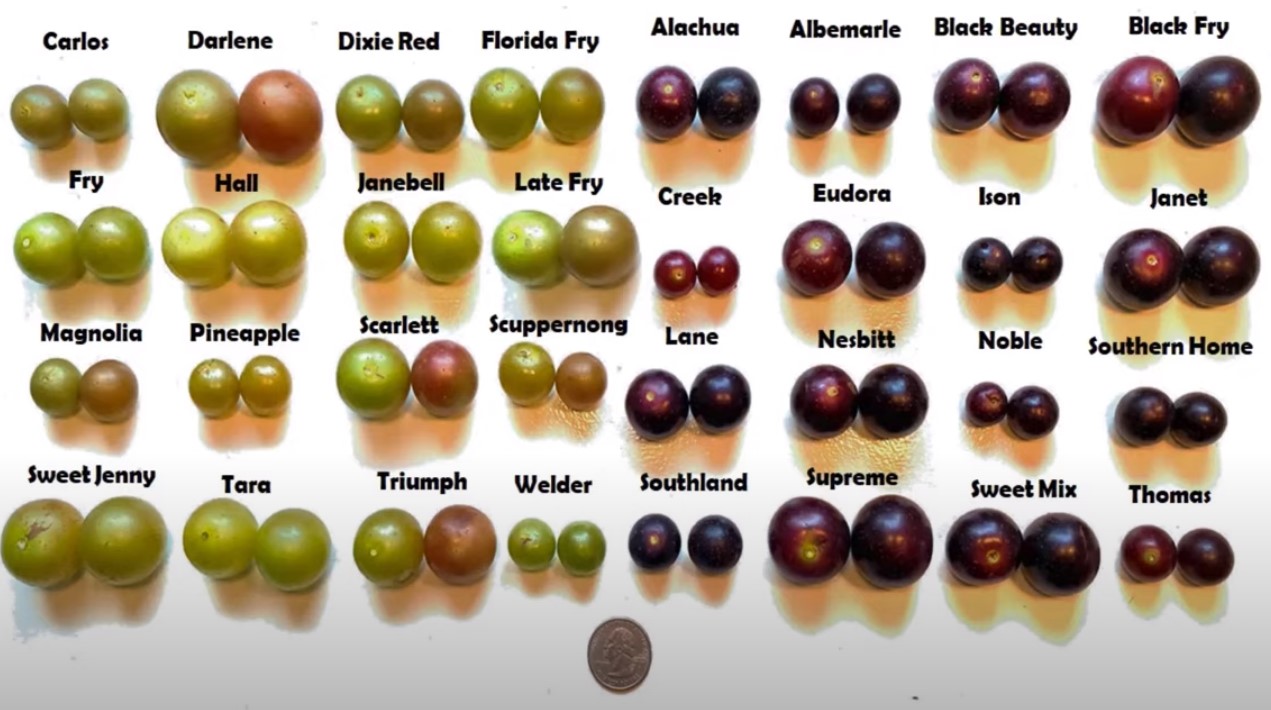
Grapevines
2021 Schedule
| Grape variety |
Image |
Type |
Size, color |
Harvest |
Notes |
Sellers |
| Flame |
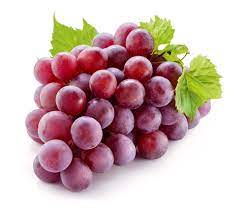 |
seedless |
red |
late-July |
One of the most popular found in grocery stores |
ISons.com |
| Reliance |
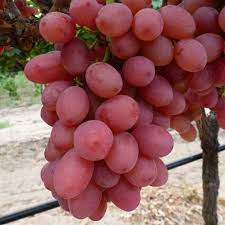 |
seedless |
purple |
July |
long shelf life, fruit matures in a wide array of colors before turning purple and ready to eat. Twice the sugar as Thompson |
Double-A-Vineyards |
| Thompson |
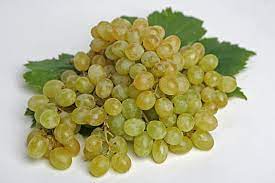 |
seedless |
greenish-white |
early-August |
|
WillisOrchards.com |
| Blueberry |
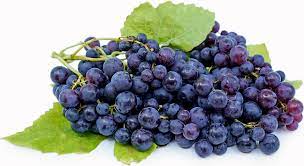 |
seedless |
blue |
mid-August |
tastes like blueberries |
WillisOrchards.com |
| Himrod |
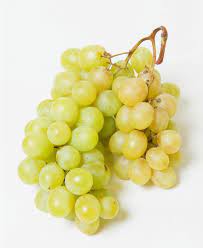 |
seedless |
green |
late-August |
honey flavored, very sweet |
Double-A-Vineyards |
| Einset |
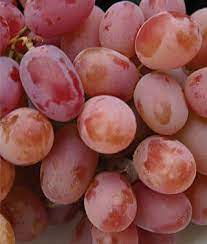 |
seedless |
red-blue |
early-September |
tastes like strawberry |
Double-A-Vineyards |
| Vanessa |
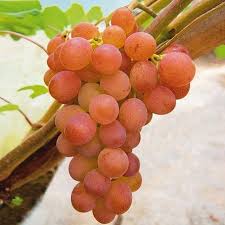 |
seedless |
red |
late-September |
exceptional fruity flavor and crisp melting texture |
Double-A-Vineyards |
|


